Exacerbation of Cisplatin Cellular Toxicity by Regulation of the Human Organic Cation Transporter 2 through Angiotensin II
Abstract
1. Introduction
2. Results
2.1. Characterization of MDCK Cells Used in This Study
2.2. Characterization of Organic Cation Transport in MDCK Cells Stably Expressing GFP or hOCT2-GFP
2.3. Pathways Possibly Involved in the Regulation of hOCT2 by AII
2.4. Influence of AII on CDDP Toxicity
3. Discussion
4. Materials and Methods
4.1. Cloning of hOCT2-GFP into the Viral Transduction Vector
4.2. Generation and Culture of MDCK Cell Lines Expressing hOCT2-GFP or GFP Alone
4.3. Immunofluorescence Analysis
4.4. Western Blot Analysis
4.5. Measurement of OCT Function
4.6. Cell Viability Test
4.7. Permeability Assay
4.8. Statistical Analysis
Supplementary Materials
Author Contributions
Funding
Institutional Review Board Statement
Informed Consent Statement
Data Availability Statement
Acknowledgments
Conflicts of Interest
References
- Gheorghe-Cetean, S.; Cainap, C.; Oprean, L.; Hangan, A.; Virag, P.; Fischer-Fodor, E.; Gherman, A.; Cainap, S.; Constantin, A.-M.; Laszlo, I.; et al. Platinum Derivatives: A Multidisciplinary Approach. J BUON 2017, 22, 568–577. [Google Scholar] [PubMed]
- Einhorn, L.H. Curing Metastatic Testicular Cancer. Proc. Natl. Acad. Sci. USA 2002, 99, 4592–4595. [Google Scholar] [CrossRef]
- Pabla, N.; Dong, Z. Cisplatin Nephrotoxicity: Mechanisms and Renoprotective Strategies. Kidney Int. 2008, 73, 994–1007. [Google Scholar] [CrossRef] [PubMed]
- Lanvers-Kaminsky, C.; Zehnhoff-Dinnesen, A.A.; Parfitt, R.; Ciarimboli, G. Drug-Induced Ototoxicity: Mechanisms, Pharmacogenetics, and Protective Strategies. Clin. Pharmacol. Ther. 2017, 101, 491–500. [Google Scholar] [CrossRef] [PubMed]
- Argyriou, A.A.; Polychronopoulos, P.; Iconomou, G.; Chroni, E.; Kalofonos, H.P. A Review on Oxaliplatin-Induced Peripheral Nerve Damage. Cancer Treat Rev. 2008, 34, 368–377. [Google Scholar] [CrossRef]
- Filipski, K.K.; Loos, W.J.; Verweij, J.; Sparreboom, A. Interaction of Cisplatin with the Human Organic Cation Transporter 2. Clin. Cancer Res. 2008, 14, 3875–3880. [Google Scholar] [CrossRef]
- Yonezawa, A.; Masuda, S.; Nishihara, K.; Yano, I.; Katsura, T.; Inui, K. Association between Tubular Toxicity of Cisplatin and Expression of Organic Cation Transporter ROCT2 (Slc22a2) in the Rat. Biochem. Pharmacol. 2005, 70, 1823–1831. [Google Scholar] [CrossRef]
- Ciarimboli, G.; Ludwig, T.; Lang, D.; Pavenstädt, H.; Koepsell, H.; Piechota, H.-J.; Haier, J.; Jaehde, U.; Zisowsky, J.; Schlatter, E. Cisplatin Nephrotoxicity Is Critically Mediated via the Human Organic Cation Transporter 2. Am. J. Pathol. 2005, 167, 1477–1484. [Google Scholar] [CrossRef]
- Sprowl, J.A.; Ciarimboli, G.; Lancaster, C.S.; Giovinazzo, H.; Gibson, A.A.; Du, G.; Janke, L.J.; Cavaletti, G.; Shields, A.F.; Sparreboom, A. Oxaliplatin-Induced Neurotoxicity Is Dependent on the Organic Cation Transporter OCT2. Proc. Natl. Acad. Sci. USA 2013, 110, 11199–11204. [Google Scholar] [CrossRef]
- More, S.S.; Li, S.; Yee, S.W.; Chen, L.; Xu, Z.; Jablons, D.M.; Giacomini, K.M. Organic Cation Transporters Modulate the Uptake and Cytotoxicity of Picoplatin, a Third-Generation Platinum Analogue. Mol. Cancer Ther. 2010, 9, 1058–1069. [Google Scholar] [CrossRef]
- Hucke, A.; Park, G.Y.; Bauer, O.B.; Beyer, G.; Köppen, C.; Zeeh, D.; Wehe, C.A.; Sperling, M.; Schröter, R.; Kantauskaitè, M.; et al. Interaction of the New Monofunctional Anticancer Agent Phenanthriplatin With Transporters for Organic Cations. Front. Chem. 2018, 6, 180. [Google Scholar] [CrossRef] [PubMed]
- Motohashi, H.; Sakurai, Y.; Saito, H.; Masuda, S.; Urakami, Y.; Goto, M.; Fukatsu, A.; Ogawa, O.; Inui, K.-I. Gene Expression Levels and Immunolocalization of Organic Ion Transporters in the Human Kidney. J. Am. Soc. Nephrol. 2002, 13, 866–874. [Google Scholar] [CrossRef] [PubMed]
- Motohashi, H.; Nakao, Y.; Masuda, S.; Katsura, T.; Kamba, T.; Ogawa, O.; Inui, K.-I. Precise Comparison of Protein Localization among OCT, OAT, and MATE in Human Kidney. J. Pharm. Sci. 2013, 102, 3302–3308. [Google Scholar] [CrossRef]
- Ciarimboli, G.; Deuster, D.; Knief, A.; Sperling, M.; Holtkamp, M.; Edemir, B.; Pavenstädt, H.; Lanvers-Kaminsky, C.; am Zehnhoff-Dinnesen, A.; Schinkel, A.H.; et al. Organic Cation Transporter 2 Mediates Cisplatin-Induced Oto- and Nephrotoxicity and Is a Target for Protective Interventions. Am. J. Pathol. 2010, 176, 1169–1180. [Google Scholar] [CrossRef] [PubMed]
- Zazuli, Z.; Duin, N.J.C.B.; Jansen, K.; Vijverberg, S.J.H.; Maitland-van der Zee, A.H.; Masereeuw, R. The Impact of Genetic Polymorphisms in Organic Cation Transporters on Renal Drug Disposition. Int. J. Mol. Sci. 2020, 21, 6627. [Google Scholar] [CrossRef] [PubMed]
- Klein, J.; Bentur, Y.; Cheung, D.; Moselhy, G.; Koren, G. Renal Handling of Cisplatin: Interactions with Organic Anions and Cations in the Dog. Clin. Investig. Med. 1991, 14, 388–394. [Google Scholar]
- Ciarimboli, G.; Lancaster, C.S.; Schlatter, E.; Franke, R.M.; Sprowl, J.A.; Pavenstädt, H.; Massmann, V.; Guckel, D.; Mathijssen, R.H.J.; Yang, W.; et al. Proximal Tubular Secretion of Creatinine by Organic Cation Transporter OCT2 in Cancer Patients. Clin. Cancer Res. 2012, 18, 1101–1108. [Google Scholar] [CrossRef]
- Sprowl, J.A.; van Doorn, L.; Hu, S.; van Gerven, L.; de Bruijn, P.; Li, L.; Gibson, A.A.; Mathijssen, R.H.; Sparreboom, A. Conjunctive Therapy of Cisplatin with the OCT2 Inhibitor Cimetidine: Influence on Antitumor Efficacy and Systemic Clearance. Clin. Pharmacol Ther. 2013, 94, 585–592. [Google Scholar] [CrossRef]
- Katsuda, H.; Yamashita, M.; Katsura, H.; Yu, J.; Waki, Y.; Nagata, N.; Sai, Y.; Miyamoto, K.-I. Protecting Cisplatin-Induced Nephrotoxicity with Cimetidine Does Not Affect Antitumor Activity. Biol. Pharm. Bull 2010, 33, 1867–1871. [Google Scholar] [CrossRef]
- Haragsim, L.; Zima, T.; Nĕmecek, K. Nephrotoxic Effects of Platinum Cytostatics—Preventative Effects of Nifedipine and Cimetidine. Sb. Lek. 1994, 95, 173–183. [Google Scholar]
- Sleijfer, D.T.; Offerman, J.J.; Mulder, N.H.; Verweij, M.; van der Hem, G.K.; Schraffordt Koops, H.S.; Meijer, S. The Protective Potential of the Combination of Verapamil and Cimetidine on Cisplatin-Induced Nephrotoxicity in Man. Cancer 1987, 60, 2823–2828. [Google Scholar] [CrossRef] [PubMed]
- Zhang, J.; Zhou, W. Ameliorative Effects of SLC22A2 Gene Polymorphism 808 G/T and Cimetidine on Cisplatin-Induced Nephrotoxicity in Chinese Cancer Patients. Food Chem. Toxicol. 2012, 50, 2289–2293. [Google Scholar] [CrossRef] [PubMed]
- Ghonaim, E.; El-Haggar, S.; Gohar, S. Possible Protective Effect of Pantoprazole against Cisplatin-Induced Nephrotoxicity in Head and Neck Cancer Patients: A Randomized Controlled Trial. Med. Oncol. 2021, 38, 108. [Google Scholar] [CrossRef] [PubMed]
- Frenzel, D.; Köppen, C.; Bauer, O.B.; Karst, U.; Schröter, R.; Tzvetkov, M.V. Ciarimboli G Effects of Single Nucleotide Polymorphism Ala270Ser (Rs316019) on the Function and Regulation of hOCT2. Biomolecules 2019, 9, 578. [Google Scholar] [CrossRef]
- Cetinkaya, I.; Ciarimboli, G.; Yalcinkaya, G.; Mehrens, T.; Velic, A.; Hirsch, J.R.; Gorboulev, V.; Koepsell, H.; Schlatter, E. Regulation of Human Organic Cation Transporter hOCT2 by PKA, PI3K, and Calmodulin-Dependent Kinases. Am. J. Physiol. Renal. Physiol. 2003, 284, F293–F302. [Google Scholar] [CrossRef]
- Koepp, T.N.; Tokaj, A.; Nedvetsky, P.I.; Conchon Costa, A.C.; Snieder, B.; Schröter, R.; Ciarimboli, G. Properties of Transport Mediated by the Human Organic Cation Transporter 2 Studied in a Polarized Three-Dimensional Epithelial Cell Culture Model. Int. J. Mol. Sci. 2021, 22, 9658. [Google Scholar] [CrossRef]
- Thomas, M.C.; Tikellis, C.; Kantharidis, P.; Burns, W.C.; Cooper, M.E.; Forbes, J.M. The Role of Advanced Glycation in Reduced Organic Cation Transport Associated with Experimental Diabetes. J. Pharmacol. Exp. Ther. 2004, 311, 456–466. [Google Scholar] [CrossRef]
- Grover, B.; Auberger, C.; Sarangarajan, R.; Cacini, W. Functional Impairment of Renal Organic Cation Transport in Experimental Diabetes. Pharmacol. Toxicol. 2002, 90, 181–186. [Google Scholar] [CrossRef]
- Grover, B.; Buckley, D.; Buckley, A.R.; Cacini, W. Reduced Expression of Organic Cation Transporters ROCT1 and ROCT2 in Experimental Diabetes. J. Pharmacol. Exp. Ther. 2004, 308, 949–956. [Google Scholar] [CrossRef]
- Harrison-Bernard, L.M. The Renal Renin-Angiotensin System. Adv. Physiol. Educ. 2009, 33, 270–274. [Google Scholar] [CrossRef]
- Saleh, S.; Ain-Shoka, A.A.; El-Demerdash, E.; Khalef, M.M. Protective Effects of the Angiotensin II Receptor Blocker Losartan on Cisplatin-Induced Kidney Injury. Chemotherapy 2009, 55, 399–406. [Google Scholar] [CrossRef] [PubMed]
- Estrela, G.R.; Wasinski, F.; Gregnani, M.F.; Freitas-Lima, L.C.; Arruda, A.C.; Morais, R.L.; Malheiros, D.M.; Camara, N.O.S.; Pesquero, J.B.; Bader, M.; et al. Angiotensin-Converting Enzyme Inhibitor Protects Against Cisplatin Nephrotoxicity by Modulating Kinin B1 Receptor Expression and Aminopeptidase P Activity in Mice. Front. Mol. Biosci. 2020, 7, 96. [Google Scholar] [CrossRef] [PubMed]
- Deegan, P.M.; Nolan, C.; Ryan, M.P.; Basinger, M.A.; Jones, M.M.; Hande, K.R. The Role of the Renin-Angiotensin System in Cisplatin Nephrotoxicity. Ren. Fail. 1995, 17, 665–674. [Google Scholar] [CrossRef] [PubMed]
- Haghighi, M.; Nematbakhsh, M.; Talebi, A.; Nasri, H.; Ashrafi, F.; Roshanaei, K.; Eshraghi-Jazi, F.; Pezeshki, Z.; Safari, T. The Role of Angiotensin II Receptor 1 (AT1) Blockade in Cisplatin-Induced Nephrotoxicity in Rats: Gender-Related Differences. Ren. Fail. 2012, 34, 1046–1051. [Google Scholar] [CrossRef]
- Tsuji, T.; Hosoda, A.; Toriyama, Y.; Yoshida, Y.; Kohno, T. Renin-Angiotensin System Inhibitors Combined with Cisplatin Exacerbate Cisplatin-Induced Nephrotoxicity in Mice. Transl. Oncol. 2022, 18, 101369. [Google Scholar] [CrossRef]
- Brast, S.; Grabner, A.; Sucic, S.; Sitte, H.H.; Hermann, E.; Pavenstädt, H.; Schlatter, E.; Ciarimboli, G. The Cysteines of the Extracellular Loop Are Crucial for Trafficking of Human Organic Cation Transporter 2 to the Plasma Membrane and Are Involved in Oligomerization. FASEB J. 2012, 26, 976–986. [Google Scholar] [CrossRef]
- Chen, X.; Zhang, J.; Zhang, M.; Liu, S.; Yan, W.; Jung, J.; Chen, X. Serine 123 Phosphorylation Modulates P21 Protein Stability and Activity by Suppressing Ubiquitin-Independent Proteasomal Degradation. J. Biol. Chem. 2012, 287, 34410–34418. [Google Scholar] [CrossRef]
- Lutz, S.E.; González-Fernández, E.; Ventura, J.C.C.; Pérez-Samartín, A.; Tarassishin, L.; Negoro, H.; Patel, N.K.; Suadicani, S.O.; Lee, S.C.; Matute, C.; et al. Contribution of Pannexin1 to Experimental Autoimmune Encephalomyelitis. PLoS ONE 2013, 8, e66657. [Google Scholar] [CrossRef]
- Ciarimboli, G.; Schlatter, E. Organic Cation Transport Measurements Using Fluorescence Techniques. In; Bönisch, H., Sitte, H.H., Eds.; Springer Science+Business Media: New York, NY, USA, 2016; pp. 173–187. [Google Scholar]
- Salomon, J.J.; Endter, S.; Tachon, G.; Falson, F.; Buckley, S.T.; Ehrhardt, C. Transport of the Fluorescent Organic Cation 4-(4-(Dimethylamino)Styryl)-N-Methylpyridinium Iodide (ASP+) in Human Respiratory Epithelial Cells. Eur. J. Pharm. Biopharm. 2012, 81, 351–359. [Google Scholar] [CrossRef]
- Kido, Y.; Matsson, P.; Giacomini, K.M. Profiling of a Prescription Drug Library for Potential Renal Drug-Drug Interactions Mediated by the Organic Cation Transporter 2. J. Med. Chem. 2011, 54, 4548–4558. [Google Scholar] [CrossRef]
- Miura, S.; Karnik, S.S. Angiotensin II Type 1 and Type 2 Receptors Bind Angiotensin II through Different Types of Epitope Recognition. J. Hypertens. 1999, 17, 397–404. [Google Scholar] [CrossRef] [PubMed]
- Dickstein, K.; Timmermans, P.; Segal, R. Losartan: A Selective Angiotensin II Type 1 (AT1) Receptor Antagonist for the Treatment of Heart Failure. Expert Opin. Investig. Drugs 1998, 7, 1897–1914. [Google Scholar] [CrossRef] [PubMed]
- Ohtawa, M.; Takayama, F.; Saitoh, K.; Yoshinaga, T.; Nakashima, M. Pharmacokinetics and Biochemical Efficacy after Single and Multiple Oral Administration of Losartan, an Orally Active Nonpeptide Angiotensin II Receptor Antagonist, in Humans. Br. J. Clin. Pharmacol. 1993, 35, 290–297. [Google Scholar] [CrossRef] [PubMed]
- Alenina, N.; dos Santos, R.A.S. Angiotensin-(1-7) and Mas. In The Protective Arm of the Renin Angiotensin System (RAS); Unger, T., Steckelings, U.M., dos Santos, R.A.S., Eds.; Academic Press: Cambridge, MA, USA, 2015; pp. 155–159. [Google Scholar] [CrossRef]
- Thieme, K.; Eguti, D.M.N.; Mello-Aires, M.; Oliveira-Souza, M. The Effect of Angiotensin II on Intracellular PH Is Mediated by AT 1 Receptor Translocation. Am. J. Physiol. -Cell Physiol. 2008, 295, C138–C145. [Google Scholar] [CrossRef] [PubMed]
- Forrester, S.J.; Booz, G.W.; Sigmund, C.D.; Coffman, T.M.; Kawai, T.; Rizzo, V.; Scalia, R.; Eguchi, S. Angiotensin II Signal Transduction: An Update on Mechanisms of Physiology and Pathophysiology. Physiol. Rev. 2018, 98, 1627–1738. [Google Scholar] [CrossRef] [PubMed]
- Biermann, J.; Lang, D.; Gorboulev, V.; Koepsell, H.; Sindic, A.; Schröter, R.; Zvirbliene, A.; Pavenstädt, H.; Schlatter, E.; Ciarimboli, G. Characterization of Regulatory Mechanisms and States of Human Organic Cation Transporter 2. Am. J. Physiol. Cell Physiol. 2006, 290, C1521–C1531. [Google Scholar] [CrossRef]
- Jehn, C.F.; Boulikas, T.; Kourvetaris, A.; Possinger, K.; Lüftner, D. Pharmacokinetics of Liposomal Cisplatin (Lipoplatin) in Combination with 5-FU in Patients with Advanced Head and Neck Cancer: First Results of a Phase III Study. Anticancer Res. 2007, 27, 471–475. [Google Scholar]
- Rajkumar, P. Cisplatin Concentrations in Long and Short Duration Infusion: Implications for the Optimal Time of Radiation Delivery. J. Clin. Diagn. Res. 2016, 10, XC01. [Google Scholar] [CrossRef]
- Guckel, D.; Ciarimboli, G.; Pavenstädt, H.; Schlatter, E. Regulation of Organic Cation Transport in Isolated Mouse Proximal Tubules Involves Complex Changes in Protein Trafficking and Substrate Affinity. Cell Physiol. Biochem. 2012, 30, 269–281. [Google Scholar] [CrossRef]
- Okui, S.; Yamamoto, H.; Li, W.; Gamachi, N.; Fujita, Y.; Kashiwamura, S.; Miura, D.; Takai, S.; Miyazaki, M.; Urade, M.; et al. Cisplatin-Induced Acute Renal Failure in Mice Is Mediated by Chymase-Activated Angiotensin-Aldosterone System and Interleukin-18. Eur. J. Pharmacol. 2012, 685, 149–155. [Google Scholar] [CrossRef]
- Crowley, S.D.; Gurley, S.B.; Herrera, M.J.; Ruiz, P.; Griffiths, R.; Kumar, A.P.; Kim, H.-S.; Smithies, O.; Le, T.H.; Coffman, T.M. Angiotensin II Causes Hypertension and Cardiac Hypertrophy through Its Receptors in the Kidney. Proc. Natl. Acad. Sci. USA 2006, 103, 17985–17990. [Google Scholar] [CrossRef] [PubMed]
- Mathe, C.; Bohacs, A.; Duffek, L.; Lukacsovits, J.; Komlosi, Z.I.; Szondy, K.; Horvath, I.; Muller, V.; Losonczy, G. Cisplatin Nephrotoxicity Aggravated by Cardiovascular Disease and Diabetes in Lung Cancer Patients. Eur. Respir. J. 2011, 37, 888–894. [Google Scholar] [CrossRef] [PubMed]
- Komaki, K.; Kusaba, T.; Tanaka, M.; Kado, H.; Shiotsu, Y.; Matsui, M.; Shiozaki, A.; Nakano, H.; Ishikawa, T.; Fujiwara, H.; et al. Lower Blood Pressure and Risk of Cisplatin Nephrotoxicity: A Retrospective Cohort Study. BMC Cancer 2017, 17, 144. [Google Scholar] [CrossRef] [PubMed]
- Kasaei, S.; Pezeshki, Z.; Karimi, F.; Lak, Z.; Choopani, S.; Talebi, A.; Nematbakhsh, M. Angiotensin 1-7 and Losartan Worsen the Cisplatin Induced Nephrotoxicity in Female Rats. J. Nephropharmacol. 2021, 11, e10. [Google Scholar] [CrossRef]
- Sabolić, I.; Asif, A.R.; Budach, W.E.; Wanke, C.; Bahn, A.; Burckhardt, G. Gender Differences in Kidney Function. Pflugers Arch. 2007, 455, 397–429. [Google Scholar] [CrossRef]
- Oswald, S.; Müller, J.; Neugebauer, U.; Schröter, R.; Herrmann, E.; Pavenstädt, H.; Ciarimboli, G. Protein Abundance of Clinically Relevant Drug Transporters in The Human Kidneys. Int. J. Mol. Sci. 2019, 20, 5303. [Google Scholar] [CrossRef]
- Schulze, U.; Brast, S.; Grabner, A.; Albiker, C.; Snieder, B.; Holle, S.; Schlatter, E.; Schröter, R.; Pavenstädt, H.; Herrmann, E.; et al. Tetraspanin CD63 Controls Basolateral Sorting of Organic Cation Transporter 2 in Renal Proximal Tubules. FASEB J. 2017, 31, 1421–1433. [Google Scholar] [CrossRef]
- Djuric, I.; Siebrasse, J.P.; Schulze, U.; Granado, D.; Schlüter, M.A.; Kubitscheck, U.; Pavenstädt, H.; Weide, T. The C-Terminal Domain Controls the Mobility of Crumbs 3 Isoforms. Biochim. Biophys. Acta 2016, 1863, 1208–1217. [Google Scholar] [CrossRef]
- Wennmann, D.O.; Vollenbröker, B.; Eckart, A.K.; Bonse, J.; Erdmann, F.; Wolters, D.A.; Schenk, L.K.; Schulze, U.; Kremerskothen, J.; Weide, T.; et al. The Hippo Pathway Is Controlled by Angiotensin II Signaling and Its Reactivation Induces Apoptosis in Podocytes. Cell Death Dis. 2014, 5, e1519. [Google Scholar] [CrossRef]
- Schulze, U.; Vollenbröker, B.; Braun, D.A.; van Le, T.; Granado, D.; Kremerskothen, J.; Fränzel, B.; Klosowski, R.; Barth, J.; Fufezan, C.; et al. The Vac14-Interaction Network Is Linked to Regulators of the Endolysosomal and Autophagic Pathway. Mol. Cell Proteom. 2014, 13, 1397–1411. [Google Scholar] [CrossRef]
- Wittwer, M.B.; Zur, A.A.; Khuri, N.; Kido, Y.; Kosaka, A.; Zhang, X.; Morrissey, K.M.; Sali, A.; Huang, Y.; Giacomini, K.M. Discovery of Potent, Selective Multidrug and Toxin Extrusion Transporter 1 (MATE1, SLC47A1) Inhibitors Through Prescription Drug Profiling and Computational Modeling. J. Med. Chem. 2013, 56, 781–795. [Google Scholar] [CrossRef] [PubMed]
- Wilde, S.; Schlatter, E.; Koepsell, H.; Edemir, B.; Reuter, S.; Pavenstädt, H.; Neugebauer, U.; Schröter, R.; Brast, S.; Ciarimboli, G. Calmodulin-Associated Post-Translational Regulation of Rat Organic Cation Transporter 2 in the Kidney Is Gender Dependent. Cell Mol. Life Sci. 2009, 66, 1729–1740. [Google Scholar] [CrossRef] [PubMed]
- Mehrens, T.; Lelleck, S.; Çetinkaya, I.; Knollmann, M.; Hohage, H.; Gorboulev, V.; Bokník, P.; Koepsell, H.; Schlatter, E. The Affinity of the Organic Cation Transporter rOCT1 Is Increased by Protein Kinase C-Dependent Phosphorylation. J. Am. Soc. Nephrol. 2000, 11, 1216–1224. [Google Scholar] [CrossRef] [PubMed]
- Cheng, H.-H.; Chou, C.-T.; Sun, T.-K.; Liang, W.-Z.; Cheng, J.-S.; Chang, H.-T.; Tseng, H.-W.; Kuo, C.-C.; Chen, F.-A.; Kuo, D.-H.; et al. Naproxen-Induced Ca 2+ Movement and Death in MDCK Canine Renal Tubular Cells. Hum. Exp. Toxicol. 2015, 34, 1096–1105. [Google Scholar] [CrossRef] [PubMed]
- Mosmann, T. Rapid Colorimetric Assay for Cellular Growth and Survival: Application to Proliferation and Cytotoxicity Assays. J. Immunol. Methods 1983, 65, 55–63. [Google Scholar] [CrossRef]
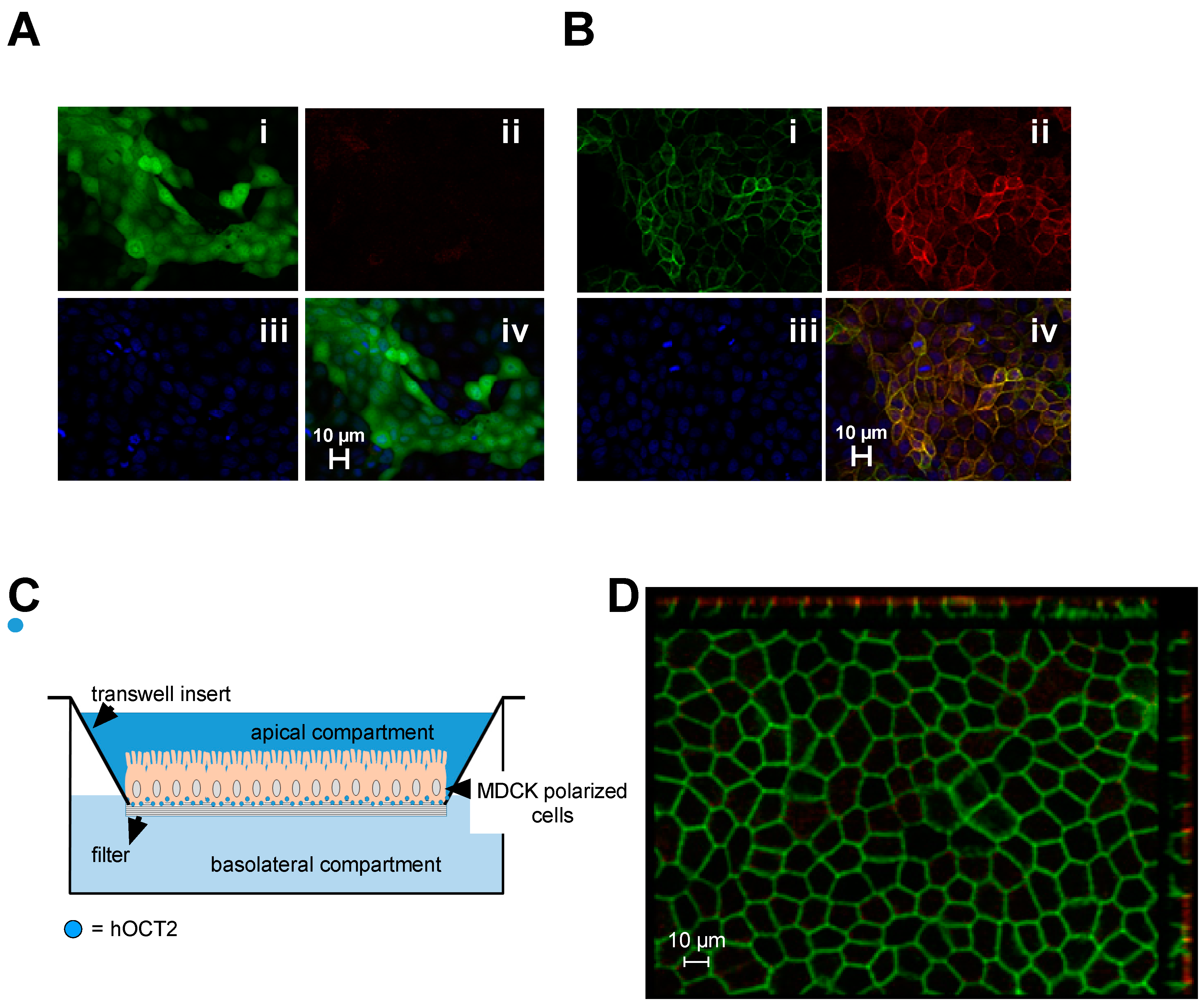
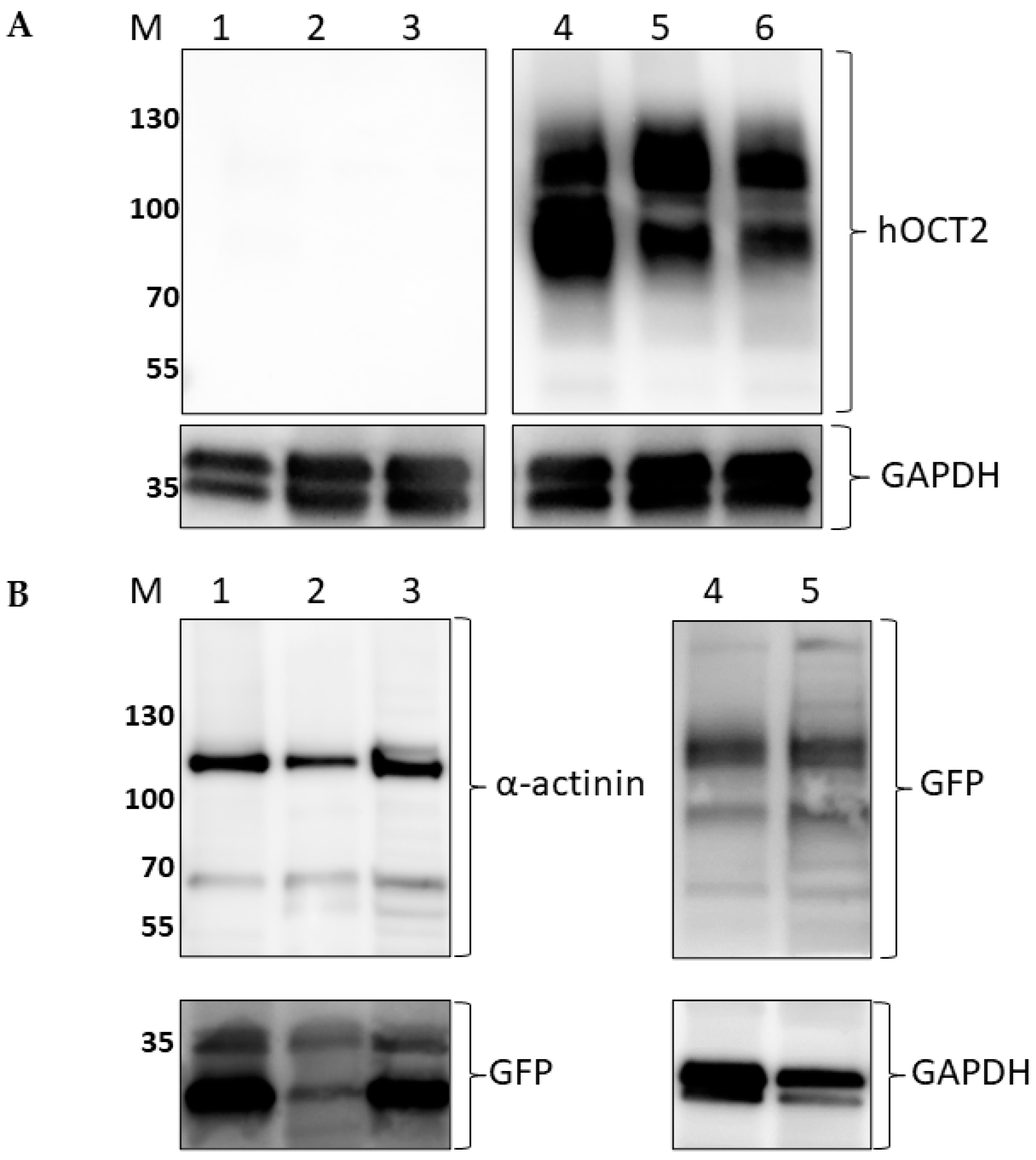
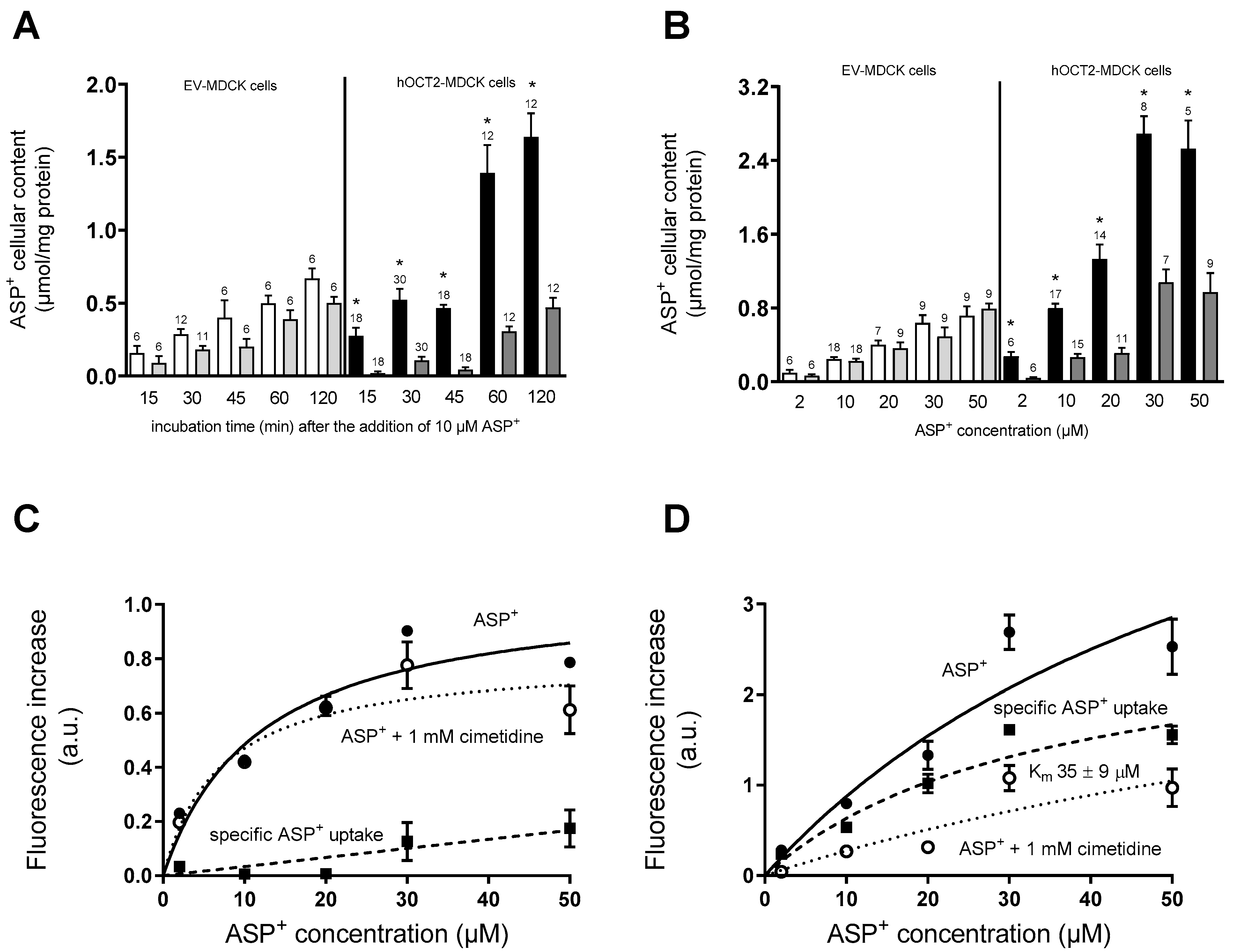
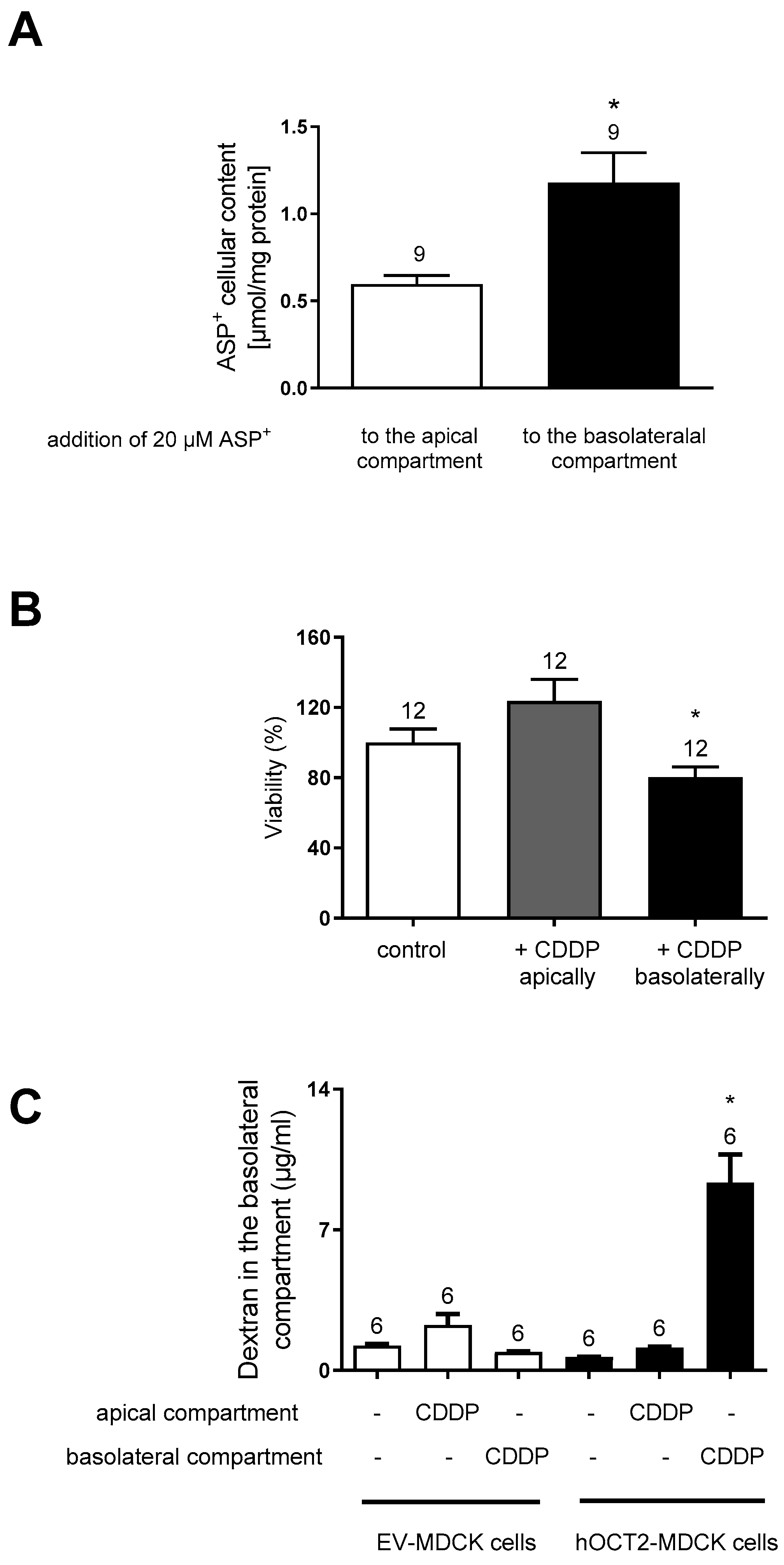

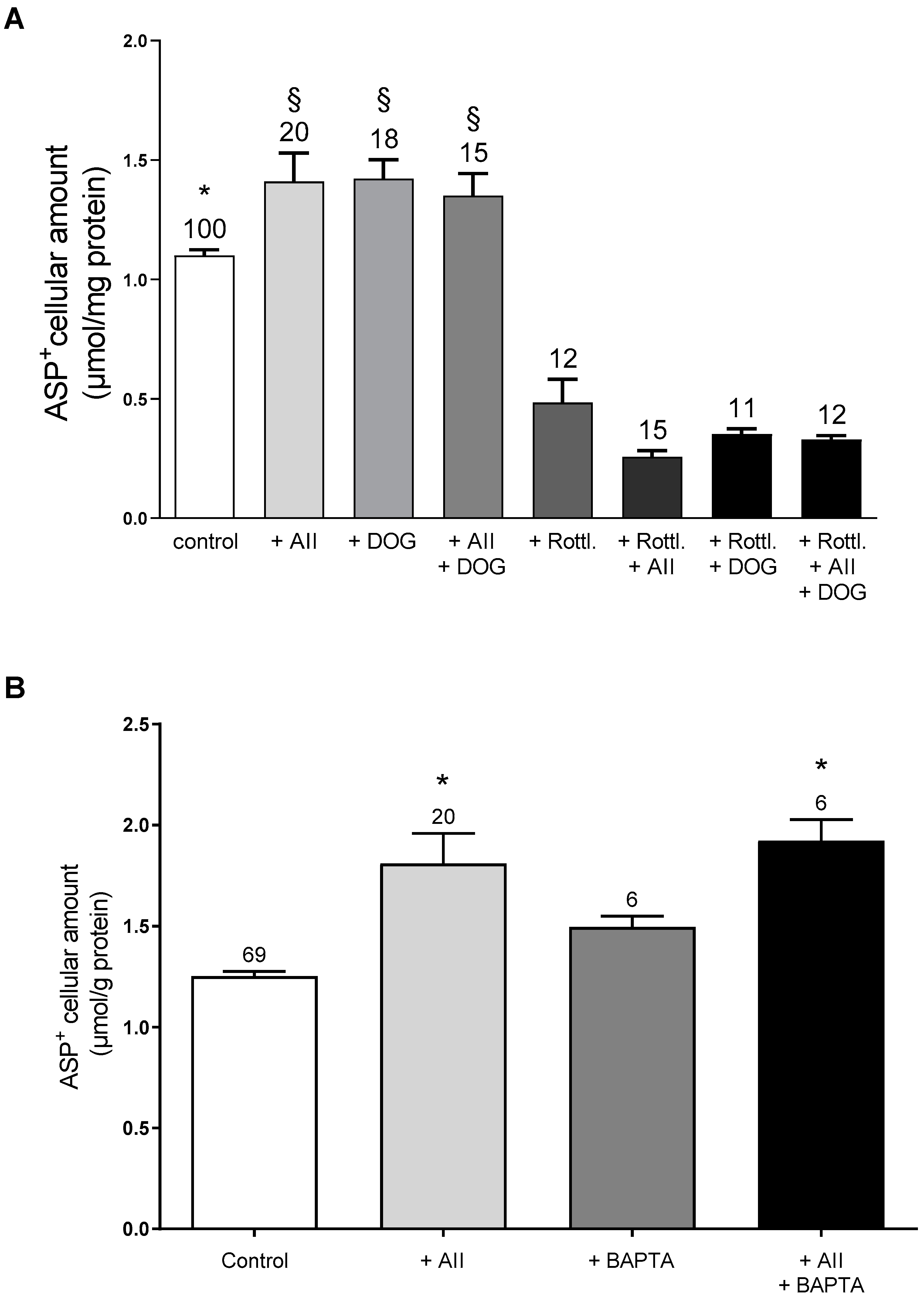
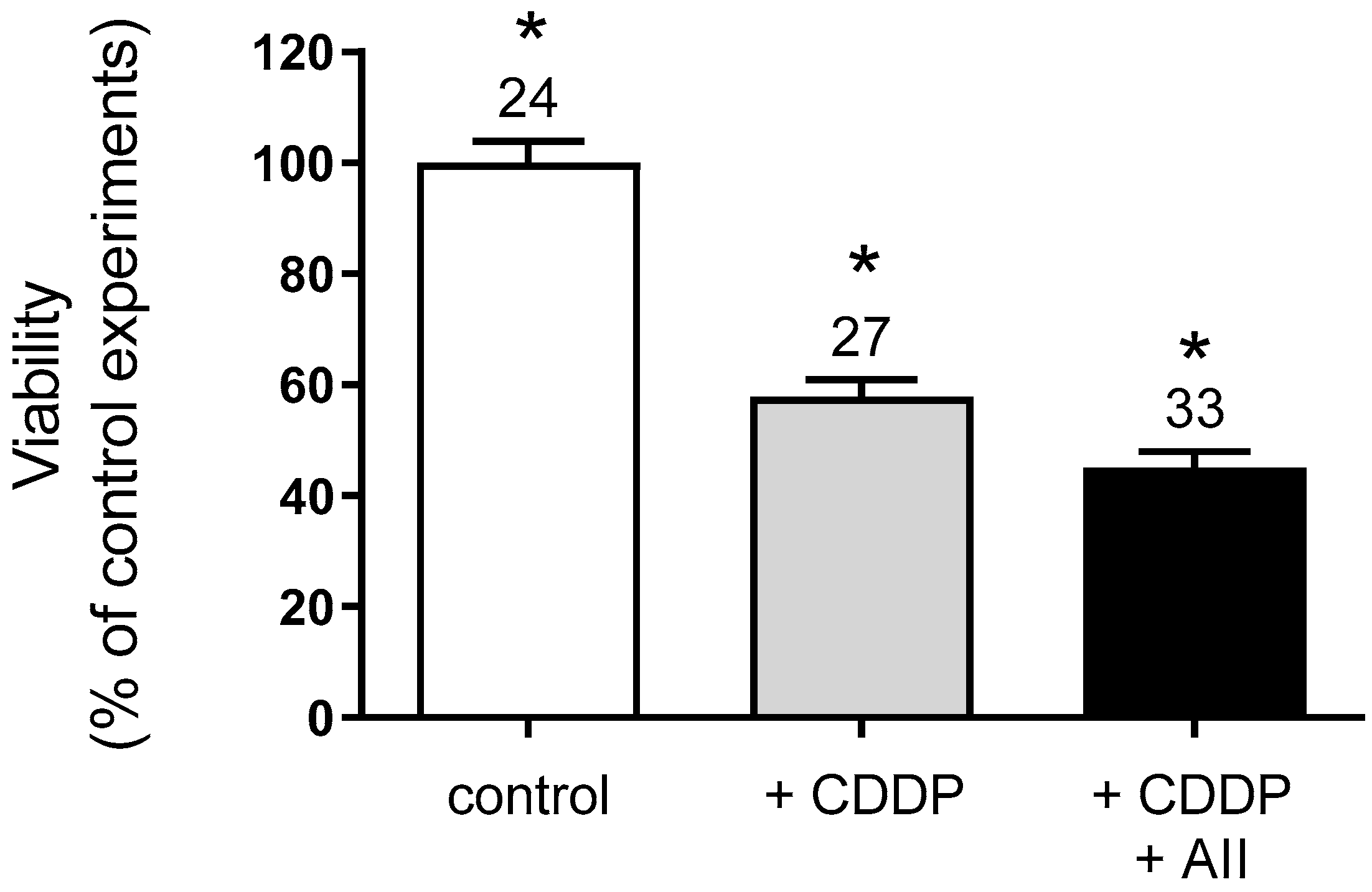
| Cloning of hOCT2 into pEGFP-N3: | |
| Forward: | CTC AGA TCT CGA GCT ATG CCC ACC ACC GTG GAC GAT |
| Reverse: | CGG GAT GGA TCC GTT CAA TGG AAT GTC TAG TTT |
| Cloning of hOCT2-GFP into pQCXIH: | |
| Forward: | GAT GCG GCC GCA TGC CCA CCA C |
| Reverse: | AAG CGG CTT CGG CCA GTA ACG TTA |
| Cloning of GFP into pQCXIH: | |
| Forward: | GAT GCG GCC GCA TGG TGA GCA AG |
| Reverse: | GCT TAA TTA ACT TGT ACA GCT CGT CCA TGC |
Publisher’s Note: MDPI stays neutral with regard to jurisdictional claims in published maps and institutional affiliations. |
© 2022 by the authors. Licensee MDPI, Basel, Switzerland. This article is an open access article distributed under the terms and conditions of the Creative Commons Attribution (CC BY) license (https://creativecommons.org/licenses/by/4.0/).
Share and Cite
Kantauskaite, M.; Hucke, A.; Snieder, B.; Ciarimboli, G. Exacerbation of Cisplatin Cellular Toxicity by Regulation of the Human Organic Cation Transporter 2 through Angiotensin II. Int. J. Mol. Sci. 2022, 23, 15866. https://doi.org/10.3390/ijms232415866
Kantauskaite M, Hucke A, Snieder B, Ciarimboli G. Exacerbation of Cisplatin Cellular Toxicity by Regulation of the Human Organic Cation Transporter 2 through Angiotensin II. International Journal of Molecular Sciences. 2022; 23(24):15866. https://doi.org/10.3390/ijms232415866
Chicago/Turabian StyleKantauskaite, Marta, Anna Hucke, Beatrice Snieder, and Giuliano Ciarimboli. 2022. "Exacerbation of Cisplatin Cellular Toxicity by Regulation of the Human Organic Cation Transporter 2 through Angiotensin II" International Journal of Molecular Sciences 23, no. 24: 15866. https://doi.org/10.3390/ijms232415866
APA StyleKantauskaite, M., Hucke, A., Snieder, B., & Ciarimboli, G. (2022). Exacerbation of Cisplatin Cellular Toxicity by Regulation of the Human Organic Cation Transporter 2 through Angiotensin II. International Journal of Molecular Sciences, 23(24), 15866. https://doi.org/10.3390/ijms232415866









